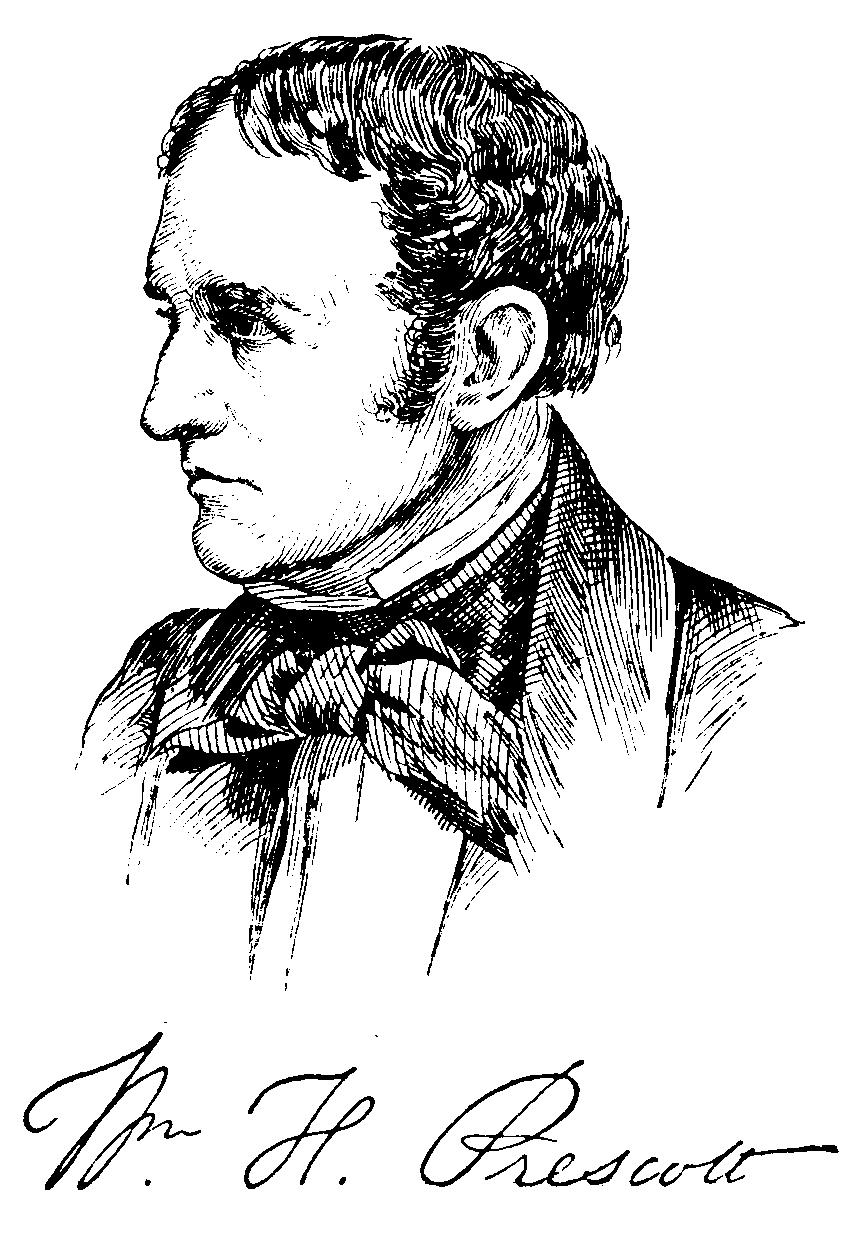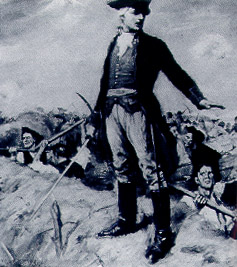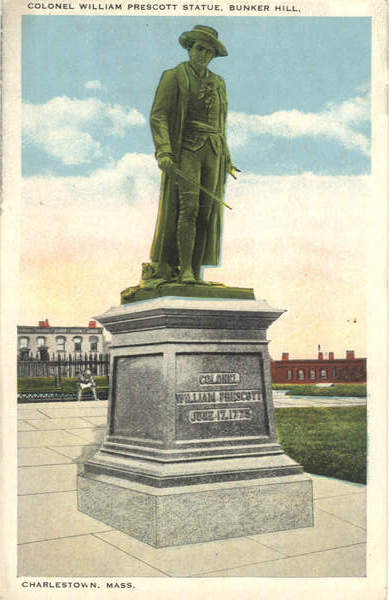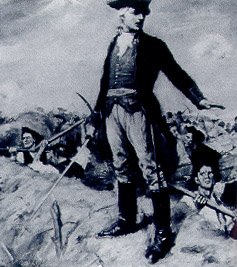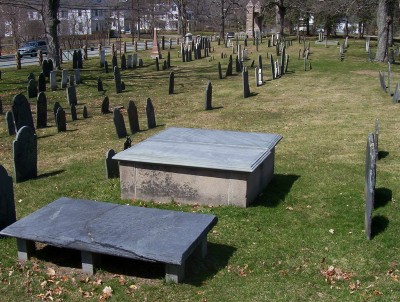| Citations |
- William Prescott, soldier, born in Groton, Massachusetts, 20 February, 1726 died in Pepperell, Massachusetts, 13 October, 1795. His father, Judge Benjamin Prescott, was the grandson of John, of Lincolnshire, England, an early settler of Lancaster, Massachusetts The son inherited a large estate and resided at Pepperell. In 1755 he served successively as lieutenant and captain in the provincial army under General John Winslow during the expedition against Nova. Scotia. His conduct in that campaign attracted the attention of the British general, who offered him a commission in the regular army, which he declined, and after the war he retired to his estate at Pepperell.
In 1774 he was appointed to command a regiment of minute-men, with which he marched, on 19 April, 1775, to Lexington, to oppose the expedition that was sent out by General Thomas Gage. Before Prescott arrived the British had retreated, and he then proceeded to Cambridge, where he entered the provincial army, the majority of his officers and men volunteering to serve with him during his first campaign. On 16 June, 1775, he was ordered to Charlestown with 1,000 men, and directed to throw up works on Bunker Hill. On arriving at the ground, it was perceived that the neighboring elevation, called Breed's Hill, was a more suitable station, and on it the defenses, consisting of a redoubt and breastwork, were erected during the night. The following day a large British force commanded by General William Howe attacked the Americans, and, after the latter had repelled two assaults, and had exhausted their ammunition, succeeded in dislodging them. In this battle, which owes its importance to the fact that it demonstrated the ability of the provincials successfully to oppose British regulars, Bancroft says that "no one appeared to have any command but Colonel Prescott," and that "his bravery could never be enough acknowledged and applauded." He was one of the last to leave the entrenchments when lie found it necessary to order a retreat, and immediately offered to retake the position if the commander-in-chief would give him three regiments.
Before the attack Gage, reconnoitering the works, saw Prescott walking on tile parapet, and asked Counselor Willard who he was, and if he would fight? The latter replied, "That is Colonel Prescott--he is an old soldier, and will fight as long as a drop of blood remains in his veins."
Early in 1777 he resigned and returned home, but in autumn of that year he joined the northern army under General Horatio Gates as a volunteer, and was present at Saratoga. After this battle he returned home and sat in the legislature of Massachusetts for several years. He wrote "A Letter from a Veteran to the Officers of the Army en-camped at Boston" (Boston, 1774). See Samuel Swett's "History of Bunker Hill Battles" (Boston, 1827 ; new ed., with notes, 1835). The illustration on page 109 represents the statue by Story erected on Bunker Hill in 1881, on which occasion an oration was delivered by Robert C. Winthrop.--His brother, Oliver, soldier, born in Groton, Massachusetts, 27 April, 1731; died there, 17 November, 1804, was graduated at Harvard in 1750, and practiced medicine in his native town.
Before the Revolution he was successively major, lieutenant-colonel, and colonel in the militia, early in 1776 he was appointed a brigadier-general of militia for the county of Middlesex, and became a member of the board of war. In 1777 he was elected a member of the supreme executive council of the state, in 1778 he was appointed third major-general of militia in the commonwealth, and in 1781 he became second major-general, but soon afterward he resigned. In this year he was commissioned by the government to cause the arrest and committal of any person whose liberty he considered dangerous to the commonwealth. From 1779 till his death he was judge of probate for Middlesex county. He was very influential in suppressing Shay's rebellion.
In 1780 he became a fellow of the Academy of arts and sciences, and he was a trustee, patron, and benefactor of Groton academy.--Oliver's son, Oliver, physician, born in Groton, Massachusetts, 4 April, 1762; died in Newburyport, 26 September, 1827, was graduated at Harvard in 1783, studied medicine with his father, and was surgeon of the forces that suppressed the Shays insurrection in 1787. Leaving a large practice in Groton, he removed to Newburyport in 1811, practicing successfully there till his death. He was often a representative in the legislature, and was a founder, trustee, and treasurer of Groton academy. He contributed valuable articles to the New England "Journal of Medicine and Surgery," but is best known by the annual discourse before the Massachusetts medical society in 1813, entitled a "Dissertation on the Natural History and Medicinal Effects of Secale Cornutum, or Ergot," which was republished in London, and translated into French and German.--William's son, William, jurist, born in Pepperell, Massachusetts, 19 August, 1762; died in Boston, 8 December, 1844, was graduated at Harvard in 1783, and taught first at Brooklyn, Connecticut, and afterward at Beverly, Massachusetts, where he studied law with Nathan Dane, and practiced successfully from 1787 till 1789.
In the latter year he removed to Salem, and after representing that town for several years in the legislature, he was elected a state senator by the Federal party for Essex county, first in 1806, and again in 1813. He twice declined a seat on the bench of the supreme court of Massachusetts In 1808 he removed to Boston, and was for several years a member of the governor's council. He was a delegate to the Hartford convention in 1814. In 1818 was appointed a judge of the court of common pleas for Suffolk, which post he soon resigned, and in 1820 was a delegate to the State constitutional convention. He was a member of the American academy of arts and sciences. The second William's son, William Niekling, historian, born in Salem, Massachusetts, 4 May, 1796; died in Boston, Massachusetts, 28 January, 1859, was graduated at Harvard in 1814, and would have devoted himself to the law but for the results of an act of folly on the part of an undergraduate, who threw at random a large, hard piece of bread, which struck one of Prescott's eyes and practically destroyed it. His other eye was soon sympathetically affected, and the youthful student was now obliged to turn his back upon the sun, and at a later period for many months to remain in a darkened room. "In all that trying season," said his mother, "I never groped my way across the apartment to take my place by his side that he did not greet me with some hearty expression of good cheer, as if we were the patients and it was his place-to comfort us."
His literary aspirations were not subdued by the sad results of this misfortune. "I had early conceived," he wrote to the Reverend George E. Ellis, "a strong passion for historical writing, to which perhaps the reading of Gibbon's autobiography contributed not a little. I proposed to make myself a historian in the best sense of the term, and hoped to produce something which posterity would not willingly let die. In a memorandum-book, as far back as the year 1819, I find the desire intimated; and I proposed to devote ten years of my life to the study of ancient and modern literatures, chiefly the latter, and to give ten years more to some historical work. I have had the good fortune to accomplish this design pretty nearly within the limits assigned. In the Christmas of 1837 my first work, the ' History of Ferdinand and Isabella, ' was given to the world. I obtained the services of a reader who knew no language but his own. I taught him to pronounce the Castilian in a manner suited, I suspect, much more to my ear than to that of a Spaniard, and we began our wearisome journey through Mariana's noble history. I cannot even now call to mind without a smile" the tedious hours in which, seated under some old trees in my country residence, we pursued our slow and melancholy way over pages which afforded no glimmering of light to him, and from which the light came dimly struggling to me through a half-intelligible vocabulary. But in a few weeks the light became stronger, and I was cheered by the consciousness of my own improvement, and when we had toiled our way through seven quartos, I found I could understand the book when read about two thirds as fast as ordinary English. My reader's office required the more patience; he had not even this result to cheer him in his labor. I now felt that the great difficulty could be overcome, and I obtained the services of a reader whose acquaintance with modern and ancient tongues supplied, as far as it could be supplied, the deficiency of eyesight on my part. But, though in this way I could examine various authorities, it was not easy to arrange in my mind the results of my reading, drawn from different and often contradictory accounts. To do this, I dictated copious notes as I went along, and when I had read enough for a chapter (from thirty to forty, and sometimes fifty, pages in length), I had a mass of memoranda in my own language, which would easily bring before me at one view the fruit of my researches. These notes were carefully read to me, and while my recent studies were fresh in my recollection I ran over the whole of my intended chapter in my mind. This process I repeated at least half a dozen times, so that when I finally put my pen to paper it ran off pretty glibly, for it was an effort of memory rather than composition. This method had the advantage of saving me from the perplexity of frequently referring to the scattered pages in the originals, and it enabled me to make the corrections in my own mind which are usually made in the manuscript, and which with my mode of writing, as I shall explain, would have much embarrassed me. Yet I must admit that this method of composition, when the chapter was very long, was somewhat too heavy a burden on the memory to be altogether recommended. Writing presented me a difficulty even greater than read-rag. Thierry, the famous blind historian of the Norman conquest, advised me to cultivate dictation" but I have usually preferred a substitute that I found in a writing-case made for the blind, which I procured in London forty years since. It is a simple apparatus, often described by me for the benefit of persons whose vision is imperfect. It consists of a frame of the size of a sheet of paper, traversed by brass wires as many as lines are wanted on the page, and with a sheet of carbonated paper, such as is used for getting duplicates, pasted on the reverse side. With an ivory or agate stylus the writer traces his characters between the wires on the carbonated sheet, making indelible marks, which he cannot see, on the white page below. This treadmill operation has its defects" and I have repeatedly supposed I had accomplished a, good page, and was proceeding in ail the glow of composition to go ahead, when I found I had forgotten to insert a sheet of writing-paper below, that my labor had all been thrown away, and that the leaf looked as blank as myself. Notwithstanding these and other whimsical distresses of the kind, I have found my writing-case my best friend in my lonely hours, and with it have written nearly all that I have sent into the world the last forty years."
The success of the history of the "Reign of Ferdinand and Isabella the Catholic" (3 vols., Boston, 1838) was great and immediate. It was published in France, Germany, and Spain in the languages of those countries, appeared in an Italian version at Florence (3 vols., 1847-'8), and early in 1858 a translation was announced in Russia. Thus encouraged, Mr. Prescott again resumed his labors, and in 1843 published a "History of the Conquest of Mexico," and in 1847 a "History of the Conquest of Peru." These works, the fruits of the most painstaking investigation into manuscript authorities, procured from Spain, proved that the critics had not been too hasty in assigning a high place to Mr. Prescott from the day of the publication of the "History of the Reign of Ferdinand and Isabella." At least one of the Mexican editions of the "Conquest of Mexico" was garbled by the translator to suit the political and religious atmosphere of the country. The Madrid edition is complete. To the French translation, by M. Amedee Pichot, a reference by Mr. Prescott will be found in the preface to the "Conquest of Peru." Mr. Prescott wrote memoirs of John Picketing and Abbott Lawrence, and in 1845 published, under the title of "Biographical and Critical Miscellanies," a selection of twelve papers from his articles contributed to the "North American Review" between 1821 and 1843, and a "Memoir of Charles Brockden Brown," originally published in Spark's "American Biography" in 1834. In the edition of the "Miscellanies" issued since 1851 will be found a valuable paper entitled "Spanish Literature," a criticism published in the "North American Review" for January, 1850, of George Ticknor's admirable "History of Spanish Literature." In the summer of 1850 Mr. Prescott visited England, and in the autumn spent a short time in Scotland and on the continent. In 1855 he published the first two volumes, and in December, 1858, the third, of what would have proved, had it been completed, his greatest work, "The History of the Reign of Philip II., King of Spain." A translation of the first two volumes appeared in Russia in 1858. In 1857 Mr. Prescott added to a new edition of Robertson's "History of the Reign of Charles V." (3 vols., Boston) a supplement (vol. iii.) entitled "The Life of Charles V. after his Abdication." Early in 1858 he experienced a slight stroke of paralysis, from the effects of which he never entirely recovered, although he was soon able to resume his usual walks, and to devote some hours daily to his books and papers. On 28 January, 1859, he received a second stroke, which terminated his life about two o'clock in the afternoon. Mr. Prescott left a widow, two sons, and a daughter It is not to be denied that the portion of history selected by Prescott for illustration in his '" Reign of Ferdinand and Isabella" had been neglected by the scholars of Germany, France, and England, and only superficially touched by Italian writers; it is equally certain that at an earlier date no faithful narration of the events of this reign could have been given to the world. Prescott had the advantage of the tragic annals of Llorente, the political disquisitions of Mariana, Sempere, and Capmany, the literal version of the Spanish-Arab chronicles by Conde, the invaluable illustration of Isabella's reign by Mr. Secretary Clemencin, many rare works and curious manuscripts purchased by his friend George Ticknor, in Spain, for his own library, and, unpublished documents of priceless value, collected from all available quarters, under the directions of the historian by the zealous agency of Alexander H. Everett, Arthur Middleton, and the learned bibliophile, Obadiah Rich. His " History of the Conquest of Mexico" is founded upon about eight thousand folio pages of unpublished duplicate of manuscripts in the collections of Don Martin Fernandez de Navaretta, other original authorities, and such printed works on the subjects discussed as had previously been given to the world In the preparation of his "History of the Conquest of Peru" Prescott used a portion of the manuscript collections that were used for the "Conquest of Mexico," a part of the unpublished documents formerly in the possession of Lord Kings-borough, and other original materials collected at great expense in England and on the continent. In the preparation of the "History of the Reign of Philip II." He is said to have employed six years.
A letter written by him from Brussels in the summer of 1850 shows the enthusiasm with which he entered into the spirit of the age of Charles V., and will probably remind the reader of the " musings" of the historian of tile "Decline and Fall of the Roman Empire amidst the Ruins of the Capitol, while tile Barefooted Friars were singing Vespers in the Temple of Jupiter." Volumes i, and ii. bring down the story to the execution of Counts Egmont and Hoorn in 1568, and to the imprisonment and death of Don Carlos. In the collection of materials for this history Mr. Prescott spared neither time, cost, personal labor, not' the services of willing friends. Public and private collections were freely opened to his use, and the long-closed doors of the ancient archives of Simancas and of other secret depositories flew open at the name of the magician whose genius had reanimated the glories of the Old World, and depicted with a vivid pencil the sorrows and desolation of the New. The reign of Charles V. is the intermediate link between the reigns of Ferdinand and Isabella and Philip II., and completes an unbroken period of 150 years of the Spanish annals. To the life of the emperor subsequent to his abdication six or seven pages only are devoted by Dr. Robertson, and these contain many errors. Robertson was unable to obtain the information then 1, raked up in the archives of Simancas. Of this information and of the labors of his predecessors, Stifling, Piehot, Gaehard, and Nigher, Mr. Prescott freely availed himself Prosper Merimee says of Prescott: "Of a just and upright spirit, he had a horror of paradox. He never allowed himself to be drawn away by it, and often condemned himself to long investigation to refute even the most audacious assertions. His criticism, full at once of good sense and acuteness, was never deceived in the choice of documents, and his discernment is as remarkable us his good faith. If he may be reproached with often hesitating, even after a long investigation, to pronounce a definite judgment, we must at least acknowledge that he omitted nothing to prepare the way for it, and that the author, too timid perhaps to decide, always leaves his reader sufficiently instructed to need no other guide." Professor Cornelius C. Felt on wrote: " It is a saying that the style is the man ; and of no great author in the literature of the world is that saying more true than of him whose loss we mourn. For in the transparent simplicity and undimmed beauty and candor of his style were read the endearing qualities of his soul, so that his personal friends are found wherever literature is known, and the love for him is co-extensive with the world of letters, not limited to those who speak our Anglo-Saxon mother language, to the literature of which he has contributed such splendid works, but co-extensive with the civilized languages of the human race."
Ref; Connecticut, 1600s-1800s, Local Families and Histories
New England Families, Vol. I, Genealogies and Memorials, Page 440
(VII) Hon. Benjamin Prescott, son of Captain Jonas Prescott was born January 4, 1696, died August 3, 1738.
Drake, Samuel G.. "Brief Memoirs and Notices of Prince's Subscribers", The New England Historical and Genealogical Register, Volume VI (1852).
Ref; Somerby, H. G.. "Pedigree of Lawrence", The New England Historical and Genealogical Register, Volume X (1856).
Ref; Gozzaldi, Mary Isabella. History of Cambridge, Massachusetts 1630-1877 with a Genealogical Register - Supplement and Index. 1930. Reprint Bowie, Maryland: Heritage Books, 1986.
Hon. Benjamin Prescott was born on 4 January 1696 at Groton, Middlesex County, Massachusetts.
He was the son of Capt. Jonas Prescott and Mary Loker.
On 12 June 1718 Hon. Benjamin Prescott was married to Abigail Oliver of Cambridge, the daughter of the Hon. Thomas Oliver. One of their sons was Col. William Prescott, the Commander of the American Forces at the Battle of Bunker Hill.
He died on Wednesday, 3 August 1735 at age 39 years, 6 months and 30 days.
He died on Sunday, 3 August 1738 at Groton, Middlesex County, Massachusetts, at age 42 years, 6 months and 30 days.
Subject: Colonel William Prescott at Bunker Hill
Source: Prescott Memorial by Dr. William Prescott, Concord, N.H. 1870
Anecdotes related to Bunker Hill told to his nephew Dr. Oliver
Prescott Jr. as reported in the Prescott Memorial
p.58-59
Dr. Oliver Prescott, Jr. was a nephew of Colonel William Prescott and
intimate in his family. He was a young man at the time of the
Revolution and had frequently heard his uncle, the Colonel, relate a
variety of anecdotes and incidents in his experience while in the army.
Oliver subsequently wrote sketches of the three brothers, to wit, his
father, Dr. Oliver Prescott, Sr., and his uncles, Colonel William
Prescott and Judge James Prescott. He wrote for his own amusement and
that of the family, in which he had recorded many interesting anecdotes
and incidents in their lives and experiences not hitherto published,
all of which he saw or heard them relate. These sketches are now in
the posession of his daughter, Miss Harriet Prescott of Cambridge, Mass., (b.
April 7, 1795; died unm) from which she kindly permitted the
following extracts to be selected. (1870)
Excerpt from Dr. Oliver Prescott's Anecdotes:
"The breast work or redoubt (at Bunker Hill) was only constructed of such
earth as the party had thrown up in the middle of the night and
was not more than breast high to a man of medium height. Colonel
Prescott being a very tall man, six feet and two or three inches in
height, his head and shoulders and a considerable portion of his body
must have been exposed during the whole engagement. He wore a three
cornered cocked hat and a ban-yan (or calico coat) His clothing was
repeatedly spattered with the blood and the brains of the killed and
wounded. Colonel Prescott did not leave the redoubt until many of the
enemy had taken possession of it. They made numerous attempts to pierce his
body with their bayonets, all of which he dexterously parried with his sword,
and he escaped without a wound. The writer,
(Dr. Oliver Prescott, Jr) saw the waistcoat and the ban-van coat after
the engagement, and they had several holes pierced by the bayonets of
the British in their attempts at his life."
The following anecdote as related by Colonel William Prescott to Oliver
is as follows:
While stationed with his regiment near New York in 1776, the out guards
brought in a British deserter. As they approached the camp the deserter
observed to the guards, "that officer yonder is Colonel Prescott." The
guards informed the Colonel of the fact. "How came you
to know me?" inquired Colonel Prescott. "I saw you on Bunker Hill,"
replied the soldier 'and recollected you immediately.' "Why did you not
kill me at that time?" asked Colonel Prescott. "I tried my best,"
said the soldier, "I took deliberate aim at you more than once when I
thought it impossible for you to escape. I also pushed at you several
times with my bayonet when you were as near as I could have wished, and
after several of us had taken possession of your works." "You are a
brave fellow," said Colonel Prescott, "come into my tent and I will treat
you."
"While on the retreat from the scene of conflict (Bunker Hill) Colonel
Prescott came to a house on Charlestown street, near the 'neck,'
where were three or four men who had just prepared a bowl of punch, and
which they presented to Colonel Prescott before having tasted it.
This, to a man suffering with fatigue and parched with thirst, was a
most gratifying and acceptable offering. Prescott took the bowl, but
before he had time to partake of its contents, a cannon ball passed
through the house, upon which the men immediately fled, leaving Colonel
Prescott to drain the bown by himself and at his leisure."
The writer of these anecdotes, nephew to Colonel William Prescott,
Dr. Oliver Prescott, Jr. was b. Feb 21, 1760.
He m. (1) Oct 22, 1791, Ann, dau of Leonard Whiting, Esq of Hollis by
whom he had nine children. She died Sept. 13, 1821 and he m. (2)
Nov 6, 1823, Elizabeth (Atkins) Oliver, widow of Thomas Oliver, Esq and
dau of Henry Atkins, Esq., a merchant in Boston. He grad. Harvard in
the Class of 1783. He was apptd a surgeon to a regiment under Colonel
Henry Woods, which, together with other regiments was under the
command of General Lincoln. These troops were collected and organized
for the purpose of supressing the Shays's rebellion. He was afterward
made surgeon of the 6th regiment of the 3d Division of militia, which
he held until he resigned in 1800. He practiced medicine at Groton, MA
until he removed with his family in February 1811 to Newburyport, MA
He continued his practice there until his death on Sept. 27, 1827 after
an illness of typhus fever, aged 66 years. His publication entitled
"Dissertation on the Natural History and Medicinal Effects of the Secale
Cornutum, or Ergot." was favorably received by the medical
profession and reprinted in Philadelphia and London and translated into
French and German and published in the 13th volume of the French
Dictionary of the Medical Sciences.
~~~~~~~~~~~~~~~~~~~~~~~~~~~~~~~~~~~~~~~~~~~~~~~~~~~~~~~~~~~~~
Transcribed by Janice Farnsworth - Colonel William Prescott, commander
of the American troops at Bunker hill was the nephew of my ancestress,
Mary Prescott (m. Benjamin Farnsworth). Mary Prescott was the sister
of Honorable Benjamin Prescott, father of Colonel William Prescott. Her
children were the Colonel's first counsins.
- [S1] Personal knowledge of Richard Prescott Bale, 12 Mar 2005, Comanded at Bunker Hill.
|
